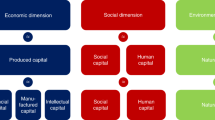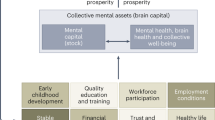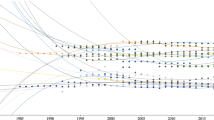Abstract
Inequity is one of the primary economic and societal risks posed by the global food system, yet measures of inequity are missing from prominent corporate tools that aim to account for the impact of the economic activities associated with food production, manufacturing and retail. Here we suggest new metrics to measure socio-economic, gender, racial, generational and risk divides between the bearers of natural, social and human capital costs and those of benefits.
This is a preview of subscription content, access via your institution
Access options
Access Nature and 54 other Nature Portfolio journals
Get Nature+, our best-value online-access subscription
$29.99 / 30 days
cancel any time
Subscribe to this journal
Receive 12 digital issues and online access to articles
$119.00 per year
only $9.92 per issue
Buy this article
- Purchase on Springer Link
- Instant access to full article PDF
Prices may be subject to local taxes which are calculated during checkout



Similar content being viewed by others
Data availability
The datasets generated during the current study are available in the Oxford Research Archive at https://ora.ox.ac.uk/objects/uuid:50c88e3a-071e-4835-a8af-9ceb945c496e. HDI and GII data are publicly available from the UNDP at http://hdr.undp.org/en/data.
Code availability
The code generated during the current study to implement optimal transport and calculate SES and SES-G statistics is available in the Oxford Research Archive at https://ora.ox.ac.uk/objects/uuid:50c88e3a-071e-4835-a8af-9ceb945c496e and can be used under the Creative Commons Attribution 2.0 (CC BY 2.0) license.
References
Rosenzweig, C. et al. Climate change responses benefit from a global food system approach. Nat. Food 1, 94–97 (2020).
Parris, K. Sustainable Management of Water Resources in Agriculture (OECD, 2010).
Kanter, D. R. & Brownlie, W. J. Joint nitrogen and phosphorus management for sustainable development and climate goals. Environ. Sci. Policy 92, 1–8 (2019).
Micha, R. et al. 2020 Global Nutrition Report: Action on Equity to End Malnutrition (Development Initiatives, 2020).
IPCC Special Report on Climate Change and Land (eds Shukla, P. R. et al.) (IPCC, 2019).
Castañeda, A. et al. Who Are the Poor in the Developing World? (World Bank, 2016).
Roe, D., Seddon, N. & Elliott, J. Biodiversity Loss is a Development Issue: A Rapid Review of Evidence (International Institute for Development, 2019).
Füssel, H.-M. How inequitable is the global distribution of responsibility, capability, and vulnerability to climate change: a comprehensive indicator-based assessment. Glob. Environ. Change 20, 597–611 (2010).
Perez-Escamilla, R. et al. Nutrition disparities and the global burden of malnutrition. Br. Med. J. 361, k2252 (2018).
Rosa, L. et al. Global agricultural economic water scarcity. Sci. Adv. 6, eaaz6031 (2020).
Dhingra, S. & Silvana, T. The Rise of Agribusiness and the Distributional Consequences of Policies on Intermediated Trade (Centre for Economic Policy Research, 2020).
Crivelli, E., de Mooij, R. A. & Keen, M. Base Erosion, Profit Shifting and Developing Countries Working Paper No. 15/118 (International Monetary Fund, 2015).
The State of Food and Agriculture 2013 (FAO, 2013).
The Business Case for Investment in Nutrition (Chatham House, 2020).
Ebi, K. L. & Hess, J. J. Health risks due to climate change: inequity in causes and consequences. Health Aff. 39, 2056–2062 (2020).
Islam, S. N. & Winkel, J. Climate Change and Social Inequality (UN, 2017).
Eccles, R. G., Krzus, M. P. & Ribot, S. Meaning and momentum in the integrated reporting movement. J. Appl. Corp. Finance 27, 8–17 (2015).
Unerman, J., Bebbington, J. & O’dwyer, B. Corporate reporting and accounting for externalities. Account. Bus. Res. 48, 497–522 (2018).
Willett, W. et al. Food in the Anthropocene: the EAT–Lancet commission on healthy diets from sustainable food systems. Lancet 393, 447–492 (2019).
Andersen, I. et al. Defining ‘science-based targets’. Natl Sci. Rev. https://doi.org/10.1093/nsr/nwaa186 (2020).
The KPMG Survey of Sustainability Reporting 2020: The Time has Come (KPMG, 2020).
PRI Why and How Investors Can Respond to Income Inequality (UNEP Finance Initiative, 2018).
Sachs, J. et al. Fixing the Business of Food. How to Align the Agrifood Sector with the SDGs (Barilla Foundation, UN Sustainable Development Solutions Network, Columbia Center on Sustainable Investment & Santa Chiara Lab University of Siena, 2020).
OECD Business and Finance Outlook 2020: Sustainable and Resilient Finance (OECD, 2020).
Negra, C. et al. Sustainable agri-food investments require multi-sector co-development of decision tools. Ecol. Indic. 110, 105851 (2020).
Fletcher, L. Food businesses bank on sustainability-linked loans. Financial Times (24 September 2020); https://www.ft.com/content/d0c721fc-2eae-4501-b95b-1660c81b05ed
2018 Global Sustainable Investment Review (Global Sustainable Investment Alliance, 2018); http://www.gsi-alliance.org/wp-content/uploads/2019/03/GSIR_Review2018.3.28.pdf
Annual Impact Investor Survey 2020 (Global Impact Investing Network, 2020).
Green Bonds Global State of the Market 2019 (Climate Bonds Initiative, 2020).
Poh, J. AB InBev signs record $10.1 billion ESG-linked facility. Bloomberg (18 February 2021); https://www.bloomberg.com/news/articles/2021-02-18/ab-inbev-signs-10-billion-loan-tied-to-sustainability-targets
Rising Trust in Sustainability Reporting Around the World (GlobeScan & GRI, 2020); https://globescan.com/rising-trust-sustainability-reporting/
Malik, S. Meet investors halfway with better ESG reporting. Forbes (3 April 2020); https://www.forbes.com/sites/forbestechcouncil/2020/04/03/meet-investors-halfway-with-better-esg-reporting/?sh=1bf697b1226b
Growing Better: Ten Critical Transitions to Transform Food and Land Use (Food and Land Use Coalition, 2019).
Better Finance, Better Food: Investing in the New Food and Land Use Economy (Blended Finance Taskforce, 2020).
Blisard, W. N. & Blaylock, J. R. Construction of true cost of food indexes from estimated Engel curves. Am. J. Agric. Econ. 73, 775–783 (1991).
Pretty, J. N. et al. Farm costs and food miles: an assessment of the full cost of the UK weekly food basket. Food Policy 30, 1–19 (2005).
The true cost of food. Nat. Food 1, 185 (2020).
Tol, R. S. J. The economic impacts of climate change. Rev. Environ. Econ. Policy 12, 4–25 (2018).
de Groot, R. et al. Global estimates of the value of ecosystems and their services in monetary units. Ecosyst. Serv. 1, 50–61 (2012).
Food Justice: The Report of the Food and Fairness Inquiry (Food Ethics Council, 2010).
TEEB for Agriculture & Food: Scientific and Economic Foundations (TEEB, 2018).
Westhoek, H. et al. Food Systems and Natural Resources (UNEP, 2016).
Kawachi, I., Subramanian, S. V. & Almeida-Filho, N. A glossary for health inequalities. J. Epidemiol. Commun. Health 56, 647–652 (2002).
Ortiz-Ospina, E. & Molteni, M. What Are PPP Adjustments and Why Do We Need Them? (Our World in Data, 2017); https://ourworldindata.org/what-are-ppps
Human Development Index (UNDP, 2020); http://hdr.undp.org/en/content/human-development-index-hdi
Gender Inequality Index (UNDP, 2020); http://hdr.undp.org/en/content/gender-inequality-index-gii
Galichon, A. Optimal Transport Methods in Economics (Princeton Univ. Press, 2016).
A New Vision of Value (KPMG International Cooperative, 2014).
Total Value: Impact Valuation to Support Decision-making (Ernst & Young, 2016).
Total Impact Measurement and Management (PWC, 2020); https://www.pwc.com/gx/en/services/sustainability/total-impact-measurement-management.html
Coulson, A. B. KPMG’s true value methodology: a critique of economic reasoning on the value companies create and reduce for society. Sustain. Account. Manage. Policy J. 7, 517–530 (2016).
Lord, S. Valuing the Impact of Food: Towards Practical and Comparable Monetary Valuation of Food System Impacts (Food System Impact Valuation Initiative, 2020).
Cohen, F., Hepburn, C. J. & Teytelboym, A. Is natural capital really substitutable? Annu. Rev. Environ. Resour. 44, 425–448 (2019).
Voora, V., Bermudez, S. & Larrea, C. Global Market Report: Cocoa (International Institute for Sustainable Development, 2019).
Cargill building $100 million cocoa facility in Indonesia. Reuters (8 May 2012); https://www.reuters.com/article/cargill-cocoa-indonesia/cargill-building-100-million-cocoa-facility-in-indonesia-idUSL2N0DO2FJ20130507
Barry Callebaut Opens Brand New 100,000 Tonne Chocolate Factory in Mexico (Barry Callebaut, 2009); https://www.barry-callebaut.com/en/group/media/news-stories/barry-callebaut-opens-brand-new-100000-tonne-chocolate-factory-mexico
Markowitz, H. M. & Todd, G. P. Mean-Variance Analysis in Portfolio Choice and Capital Markets (Wiley, 2000).
Headey, D. & Shenggen, F. Reflections on the Global Food Crisis (International Food Policy Research Institute, 2010).
AlphaBeta Valuing the SDG Prize in Food and Agriculture: Unlocking Business Opportunities to Accelerate Sustainable and Inclusive Growth (Business and Sustainable Development Commission, 2016).
Bosc, P.-M. et al. Investing in Smallholder Agriculture for Food Security: A Report by the High Level Panel of Experts on Food Security and Nutrition (Committee on World Food Security, 2013).
Leveraging Small and Medium Enterprises to Improve Nutrition (FAO & GAIN, 2018).
Akkermans, D. H. Net profit flow per country from 1980 to 2009: the long-term effects of foreign direct investment. PLoS ONE 12, e0179244 (2017).
Ricke, K. et al. Country-level social cost of carbon. Nat. Clim. Change 8, 895–900 (2018).
The Changing Landscape of Agricultural Markets and Trade: Prospects for Future Reforms (OECD, 2019).
Growing support for valuing ecosystems will help conserve the planet. Nature 591, 178 (2021).
Akerloff, G. et al. Economists’ statement on carbon dividends. Wall Street Journal (16 January 2019).
Author information
Authors and Affiliations
Contributions
S.L. conceived the article, performed the research and wrote the article. J.S.I.I. contributed to content, research and writing of the article.
Corresponding author
Ethics declarations
Competing interests
S.L. receives funding from the Food System Impact Valuation Initiative. The Food System Impact Valuation Initiative is funded by the Global Alliance for the Future of Food, Compassion in World Farming UK, World Business Council on Sustainable Development, the Sir Peter Elworthy Grant Programme, Nestle UK & Ireland, Danone and Yara International. The funders had no role in the conceptualization, design, analysis, decision to publish, or preparation of the manuscript. J.S.I.I. declares no competing interests.
Additional information
Peer review information Nature Food thanks Paul Winters, Valeria Pineiro and the other, anonymous, reviewer(s) for their contribution to the peer review of this work.
Publisher’s note Springer Nature remains neutral with regard to jurisdictional claims in published maps and institutional affiliations.
Supplementary information
Supplementary Information
Supplementary Discussion
Rights and permissions
About this article
Cite this article
Lord, S., Ingram, J.S.I. Measures of equity for multi-capital accounting. Nat Food 2, 646–654 (2021). https://doi.org/10.1038/s43016-021-00336-3
Received:
Accepted:
Published:
Issue Date:
DOI: https://doi.org/10.1038/s43016-021-00336-3



